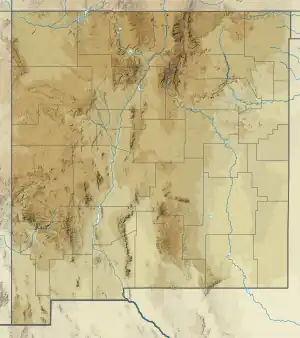Cerro Conejo Formation
The Cerro Conejo Formation is a middle to late Miocene geologic formation exposed near Albuquerque, New Mexico.[1][2]
| Cerro Conejo Formation | |
|---|---|
| Stratigraphic range: Miocene, | |
 Cerro Conejo Formation in road cut along U.S. 550, New Mexico, USA | |
| Type | Formation |
| Unit of | Santa Fe Group |
| Underlies | Arroyo Ojito Formation |
| Overlies | Zia Formation |
| Thickness | 316 meters (1,037 ft) |
| Lithology | |
| Primary | Arkose |
| Other | Mudstone |
| Location | |
| Coordinates | 35.4089°N 106.8338°W |
| Region | New Mexico |
| Country | United States |
| Type section | |
| Named for | Cerro Conejo |
| Named by | Connell, Koning, and Cather |
| Year defined | 1999 |
 Cerro Conejo Formation (the United States)  Cerro Conejo Formation (New Mexico) | |
Gravel beds within the formation in the Rio Puerco valley west of Albuquerque have provided clues to the paleogeography of the Grants area since the early Miocene.
Description
The Cerro Conejo Formation is composed of very light brown to pink or yellowish-red, fine- to medium-grained, well-sorted, medium- to thick-bedded sandstone. The beds are tabular and locally cross-stratified and include occasional thinly bedded mudstone. Sandstone grains are subrounded and frosted. The formation also contains numerous white to light greenish gray volcanic ash beds. The total thickness is 316 meters (1,037 ft). The formation overlies the Zia Formation and interfingers with the overlying Arroyo Ojito Formation.[2]
One of the ash beds within the formation yielded a K-Ar age of 13.64 +/-0.09 million years (Ma.[3] The overall age range is constrained to between 14.8 and 9.5 Ma.[4]
Gravel beds within the formation in the Rio Puerco valley west of Albuquerque have provided clues to the paleogeography of the Grants area since the early Miocene. These beds have been assigned to the informal Benavidez Member.[5]
Fossils
The formation has yielded vertebrate fossils at the Rincon and Zia quarries that are characteristic of the middle to late Miocene (Barstovian to Clarendonian).[3]
History of investigation
The unit was first defined by Connell and his collaborators in 1999 as the Cerro Conejo Member of the Zia Formation. It was named for exposures along Arroyo Ojito near Cerro Conejo, a small hill northwest of Albuquerque. Arroyo Ojito was also designated as the type locality (no type section defined).[1] Tedford and Barghoon recommended that the Cerro Conejo Member be reassigned to the Arroyo Ojito Formation, since there was a significant unconformity (corresponding to a pause in sediment deposition of 1 to 1.6 Ma) separating the Cerro Conejo from the rest of the Zia Formation.[3]
In 2007, Williams and Cole recommended that the Arroyo Ojito Formation be abandoned, because the name was being used inconsistently and because the formation straddled a significant region unconformity,[6] since named the Rincones paleosurface.[7] They promoted the Ceja Member, which lay above the Rincones paleosurface, to formation rank, and moved the remaining members of the Arroyo Ojito into an informal "Middle Red" formation, recalling the earliest subdivisions of the Santa Fe Group.[6] Connell responded the next year by concurring with the promotion of the Ceja Formation (which he divided into Santa Ana Mesa and Atrisco Members), promoting the Cerro Conejo to formation rank, and retaining the middle beds as the Arroyo Ojito.[2]
Footnotes
References
- Connell, S.D. (2008). "Refinements to the stratigraphic Santa Fe Group, northwestern Albuquerque basin, New Mexico" (PDF). New Mexico Geology. 38 (1): 14–35. Retrieved 11 August 2020.
- Connell, S.D.; Koning, D.J.; Cather, S.M. (1999). "Revisions to the stratigraphic nomenclature of the Santa Fe Group, northwestern Albuquerque basin, New Mexico" (PDF). New Mexico Geological Society Field Conference Guidebook. 50: 337–354. Retrieved 11 August 2020.
- Koning, Daniel J.; Heizler, Mattew; Jochems, Andrew (2020). "Clues from the Santa Fe Group for Oligocene-Miocene paleogeography of the southeastern Colorado Plateau near Grants,New Mexico" (PDF). New Mexico Geoloical Society Special Publication. 14: 153–166. Retrieved 23 October 2020.
- Tedford, R.H.; Barghoon, Steven (1999). "Santa Fe Group (Neogene), Ceja del Rio Puerco, northwestern Albuquerque basin, Sandoval County, New Mexico" (PDF). New Mexico Geological Society Field Conference Guidebook. 50: 327–336. Retrieved 11 August 2020.
- Williams, P.L.; Cole, J.C. (2007). "Geologic map of the Albuquerque 30' x 60' quadrangle, north-central New Mexico" (PDF). U.S. Geological Survey Scientific Investigations Map. Scientific Investigations Map. SIM-2946. doi:10.3133/sim2946. hdl:2027/mdp.39015049951992. Retrieved 11 August 2020.